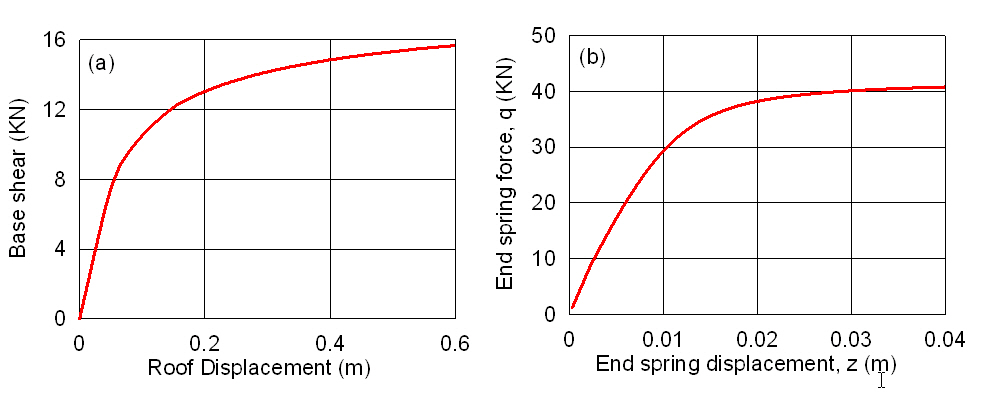Contact Author: |
Prishati Raychowdhury
prishati @ earthmech.com prishati @ gmail.com
|
ShallowFoundationGen command generates (i) the node numbers and corresponding coordinates for foundation and spring elements, (ii) material type and properties of each created element, and (iii) nodal fixity required to define a two-dimensional Beam-on-Nonlinear-Winkler-Foundation (BNWF) model.
ShallowFoundationGen $FoundationTag $ConnectNode $InputFileName $FootingCondition
|
|
||
$FoundationTag |
integer defining foundation number* |
||
$ConnectNode |
integer defining structural node that is to be connected with the middle node of the foundation** |
||
$InputFileName |
character defining name of the input file containing soil and footing properties*** |
||
$FootingCondition |
integer (value ranging from 1 to 5) defining foundation condition**** |
||
|
|
|
|
|
|
|
|
*NOTE: An intermediate file containing the mesh details will be generated and will be named as per the FoundationTag specified. For example, if a structure has three shallow foundations, and the foundations are numbered as 1, 2 and 3, then the FoundationTags for those three foundations would be 1, 2 and 3, respectively, and the OpenSees generated intermediate output files will automatically be named as "Foundation_1.tcl", "Foundation_2.tcl" and "Foundation_3.tcl", respectively.
**NOTE: the code assumes that the structure is supported at the center of a symmetric footing. For example, if the user specifies the ConnectNode to be 1, node 1 of the structure will be connected to the mid node of the shallow foundation, and the degrees of freedom of these two nodes will be the same (i.e. same generalized displacements for these two nodes).
***NOTE: The uncommented lines (lines that are not starting with #) of this file should be in the following sequence:
where SoilType implies type of soil (i.e., sand or clay). SoilType = 1 represents clay and SoilType = 2 represents sand. Intermediate soil types (such as silt) have to be represented by either sand or clay depending upon their relative dominance; c =Cohesion, phi = Friction angle (in degree), gamma = Unit weight, G = Shear modulus, nu = Poisson's ratio, crad = Radiation damping (in fraction), TP = Tension capacity (in fraction of bearing capacity, maximum value is 0.1), Lf = Length of footing, Bf = Width of footing, Hf = Height of footing, Df = Depth of embedment, Ef = Young's modulus for footing material, beta =Inclination of the load on the foundation with respect to vertical direction, (in degree), Rk = Stiffness intensity ratio of vertical springs (kend/kmid), Re = End length ratio (Lend/Lf ) and Se = vertical spring spacing as a fraction of total footing length (le/Lf ).
If user wants to input the foundation strength and stiffness directly instead of allowing the command to calculate those, first command line can be replaced with the following alternate command line:
CapSoil $Qult $Pult $Tult $Kv $Kh
where, Qult = Vertical bearing capacity, Pult = Passive resistance capacity, Tult = Sliding resistance capacity, Kv = Vertical stiffness of footing and Kh = Lateral stiffness of footing.
****NOTE: footings with different base conditions will be generated as follows:
$FootingCondition = 1: |
Foundation is fixed |
|
$FootingCondition = 2: |
ZeroLength Elastic springs in the vertical direction, sliding restrained |
|
$FootingCondition = 3: |
ZeroLength Elastic springs in the vertical and horizontal direction |
|
$FootingCondition = 4: |
ZeroLength springs with QzSimple2 material in the vertical direction, sliding restrained |
|
$FootingCondition = 5: |
ZeroLength springs with QzSimple2 material in the vertical direction, two ZeroLength springs one with PxSimple1 material and the other with TxSimple1 material in the horizontal direction |
|
|
|
|
Note that QzSimple2, PxSimple1 and TxSimple1 materials (Raychowdhury 2008) are modified versions of QzSimple1, PySimple1 and TzSimple1 materials introduced by Boulanger (2000).
For details of the mesh generation, calculation methods, additional examples and other relevant details, please look into ShallowDocumentation.pdf

Figure 1 : Mesh generation by ShallowFoundationGen command (Example 1)

Figure 2: Results for (a) Wall force-displacement response (b) Extreme end
vertical spring response (Example 1)
REFERENCES
Raychowdhury, P. (2008). "Nonlinear Winkler-based Shallow Foundation Model for Performance Assessment of Seismically Loaded Structures". PhD Dissertation, University of California, San Diego.
Boulanger, R. W. (2000). "The pysimple1, qzsimple1 and tzsimple1 material documentation." Documentation for the OpenSees platform available at: http://opensees.berkeley.edu/.